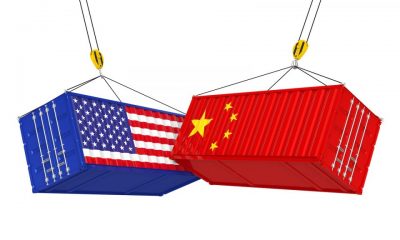The China-US Phase One Trade Deal: Deep Seated Crisis Unresolved

The phase one deal leaves major bilateral differences unresolved. Further talks could continue intermittently for years without resolution.
The US aims to weaken China economically, financially, industrially, technologically and militarily, part of its Indo/Pacific strategy to dominate the region.
China’s President Xi Jinping was noticeably absent from Wednesday’s signing ceremony, declining Trump’s invitation, Vice Premier Liu He representing Beijing in the White House East Room.
Beijing long ago agreed to much of what’s included in the phase one deal. Negotiations could have been concluded in 2018 if the Trump regime accepted then what’s agreed on now.
According to the South China Morning Post (SCMP), details of the deal weren’t available in China for over eight hours after Wednesday’s signing ceremony.
According to the official People’s Daily broadsheet, the phase one deal “came 22 months after trade tensions flared between the world’s top two economies in March 2018,” adding:
Wednesday’s signing ceremony temporarily “reduce(s) uncertainties that have dampened business investment moods in both countries and beyond.”
Resolving the toughest issues lies ahead. China clearly won’t bend to US interests at the expense of its longterm development goals.
Under terms of the deal,
“China will increase imports of US agricultural products, and the US will gradually eliminate its tariffs on Chinese goods,” the People’s Daily explained, adding:
“The deal covers intellectual property rights, technology transfers, food and agricultural products, financial services, exchange rates and transparency.”
According to China Center for International Economic Exchanges vice president Wei Jianguo, both countries will likely “step on each other’s feet” ahead, but further dialogue will follow the agreement reached.
The official Xinhua news agency said the phase one deal is only “a good start” in a dispute that’s “longterm, complicated and arduous.”
Wednesday’s signing ceremony came at a time when the Trump regime is preparing new restrictions on Chinese telecom giant Huawei’s access to US technology, along with pressuring Britain, Germany, and other European countries to distance themselves from the company.
According to academic Wang Heng, phase two negotiations “may involve more difficult domestic regulatory issues such as subsidies, state-owned enterprises, and internet supervision,” adding:
“Due to the complexity of the negotiations, it remains to be seen whether the two parties can reach a second-stage agreement.”
“If market competition rules such as subsidies are not agreed upon, economic and trade frictions may continue and affect the two countries and the international economy.”
Economist Shen Jianguang stressed that considerable obstacles lie ahead, future disputes likely, adding:
“Since the trade war started, the strategic mutual trust between China and the United States has retrogressed.”
“Frictions and disputes in other areas have also occurred frequently. We need to prepare comprehensively for the complexity of Sino-US relations and long-term battle.”
What both countries agreed to and what unfolds ahead may diverge greatly, depending on how major bilateral differences between both countries are handled and global economic conditions.
According to the US released phase one text, China agreed to buy increased amounts of US soybeans, oilseeds, beef, pork, grains, cotton, other agricultural products, as well as billions of dollars worth of US oil, gas, coal, nuclear power equipment, other manufactured goods, and services.
Under terms of the phase one deal, China will buy $32.9 billion worth of US manufactured goods this year and $44.8 billion in 2021; $12.5 billion in US agricultural goods this year and $19.5 billion in 2021; $18.5 billion in US energy products this year and $33.9 billion in 2021; and $12.8 billion in US services this year and $25.1 billion in 2021.
The total amount of Chinese purchases are to be at least $200 billion more from January 1, 2020 to December 31, 2021 than the amount of US goods bought in 2017.
Beijing earlier said its imports will depend on internal needs. Its ruling authorities also have commitments with other trading partner nations they likely wish to maintain.
The US and China recognized the importance of establishing a legal system to protect intellectual property.
Both countries agreed not to engage in competitive currency devaluation.
US-based Public Citizen’s Global Trade Watch is skeptical about how Sino/US trade will play out ahead, tweeting:
“Trump believes his phase one #China deal will yield great benefits for US farmers, producers and other exporters. But his deal may not amount to more than a hill of soybeans.”
What’s officially called “fully enforceable” may not turn out as expected.
The US and China are rivals, not partners. Growing prominence of other nations on the world stage conflicts with US geopolitical aims.
Its rage to dominate other nations, fueling distrust in Beijing and elsewhere, may be the greatest obstacle in the way of resolving major differences ahead.
Despite agreement on a phase one deal, major irreconcilable differences between both countries may remain unresolvable no matter how many more rounds of talks are held.
*
Note to readers: please click the share buttons below. Forward this article to your email lists. Crosspost on your blog site, internet forums. etc.
Award-winning author Stephen Lendman lives in Chicago. He can be reached at [email protected]. He is a Research Associate of the Centre for Research on Globalization (CRG)
His new book as editor and contributor is titled “Flashpoint in Ukraine: US Drive for Hegemony Risks WW III.”
http://www.claritypress.com/LendmanIII.html
Visit his blog site at sjlendman.blogspot.com.

